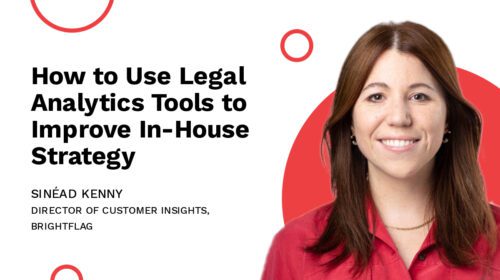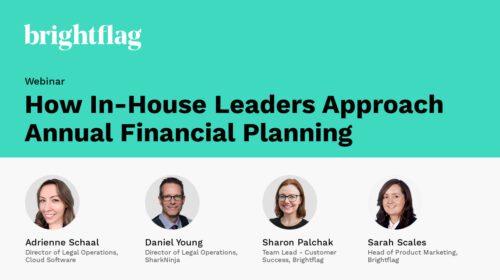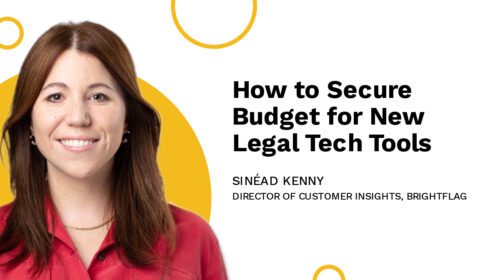Predicting Legal Spend: Taking Away the Fear
Predicting legal spend can feel equivalent to wrapping your arms around a spinning cyclone. If you aren’t sure what costs you can anticipate month to month, how can you possibly predict it long term?
As a result, predicting legal spend is often feared and incorrectly perceived as an impossible task. But for the most part it is predictable and you can anticipate future spend.
This article is here to help you tame the cyclone and accurately predict legal spend without feeling blown away. We share why it’s important, how you can get started, and how legal spend management software makes it possible.
Three Reasons Why Predicting Legal Spend Matters
It Allies Legal with Finance
Financial Planning and Analysis, or FP&A, is the process of planning, forecasting, budgeting, and analyzing an organization’s expenses. This feeds into your organization’s annual budget planning process.
Depending on the size of your organization, FP&A may be managed by an individual or a dedicated team. Either way, the financial planning and cash flow management FP&A does impacts how your organization grows over time.
Therefore, teams that predict their legal spend are viewed by FP&A as an important organizational ally.
Supporting FP&A elevates legal’s perception from cost center to key stakeholder directly impacting achievement of short- and long-term goals.
It Gives Legal a Seat at the Leadership Table
Legal is a critical arm of any organization that directly impacts the company’s trajectory. The problem is they aren’t always seen as such. Many senior executives consider legal an expensive necessity they would prefer to do without.
This misconception is reinforced when legal’s response to financial queries is, “I can’t tell you what it’s going to cost.” In contrast, true organizational stakeholders have predictable expenditures, most of which are correlated to specific outcomes.
Predicting spend flips that script, empowering legal to say, “I not only can tell you how much this is going to cost, I can also break it out for you quarter by quarter.”
Taking legal spend out of its opaque, black box and making it fully transparent elevates in-house legal to a strategic partner. Once there, legal can share valuable insights, contribute to annual planning, and gain more control over their department.
It Brings Legal into Budget Discussions
Will legal’s budget be cut? Will an already burned-out legal team be asked to bring more work in-house?
Legal teams that predict spend don’t have to wait to see what the answers to questions like these are. Once legal is seated alongside other stakeholders, they have a greater impact on the business’s financial planning and the future of their team.
When budget cut discussions arise, legal leadership that predicts their spend can present a data-backed case as to the right choice. It may well be that legal’s budget needs to remain as-is (or be increased) to best support the organization.
Now that we understand why predicting legal spending is worthwhile let’s talk about what might be holding you back from tackling it.
First, We Organize, Then We Predict
Predicting legal spend can feel like an impossible task if you try to put your arms around all of it at once. But if you can think about the process of predicting legal spend categorically, everything will fall into place.
So let’s get started! First, we’ll organize your legal spend data into three groups:
- Legal spend you can predict with an annual plan
- Other legal spend you can predict
- Legal spend you can’t predict
Looking at your legal spend data this way helps you understand where you need to pull information from, and who you need to collaborate with to obtain it.
Identifying the legal spend you can’t predict is equally helpful, as it prevents you from investing energy that’s better spent focusing on what you can predict.
Now that we’ve broken legal spend into three categories let’s look at how you can collect the data you need.
The Three Categories of Legal Spend
Legal spend you can predict with an annual plan
When determining whether a type of legal spend is predictable, ask yourself, “Is there a business metric that drives this type of work?” If the answer’s yes, you can reliably predict the legal costs associated with it.
It’s unrealistic to know which issues will arise in the coming year. However, you can anticipate their magnitude and volume based on what the rest of the organization has outlined in the annual plan.
Below are a few examples of what you can predict using your organization’s annual plan:
- Commercial Contracts: These costs are typically related to the number of customers your organization expects to have and the revenue they expect to receive.
- Employment: These costs are usually connected to the number of hires your organization plans to make. While there are unpredictable costs that can occur (e.g., with layoffs), your organization has forecasted things like hiring, employee incidents, etc.
- Financing: Organizations go into annual planning with clear and well-tested assumptions around the financing they’ll require in the coming year. Whether equity financing, debt financing, or an IPO, the legal costs associated can be well understood.
- Intellectual Property (IP): IP spend is typically a function of Research & Development expense. You can determine future costs by looking at the projected number of patents and trademarks that R&D is planning for.
- Mergers and Acquisitions (M&A): Organizations go into a new year with a corporate development strategy and plan.
- Real Estate: If you have a significant real estate footprint, the budget for legal supporting this will be part of annual planning. For example, a retail company will have a plan for how many stores they plan to open and renew in any given year.
Other Legal spend you can predict
Some legal costs appear unpredictable because they aren’t part of annual planning. In these instances, you can use a combination of historical data and investigation to get a good estimate. Examples include:
Ongoing, “bet-the-company” litigation
These are instances of litigation that have been going on for some time, and there’s uncertainty around whether or not they’ll be settled, dismissed, or continue.
You can’t know for sure how this kind of litigation will play out but can know:
- What stage the litigation is in
- What the momentum is, and whether it’s likely to be resolved in the near term or further in the future
- Vendor estimated costs for the remainder of the litigation
Ordinary, “par-for-the-course” litigation
Every company of a certain size ends up with some number of disputes. The larger the company, the more disputes. You can look at the number of lawsuits your company has experienced, correlate that to your organization’s growth, and come up with a relatively reliable estimate.
Regulatory changes
As an organization, you don’t have control over what new regulations you will be subjected to. But governments don’t move at lightning speed, and regulatory changes typically take longer than a year to be put into effect. You can look ahead to determine which regulatory changes will be coming up and budget for them accordingly.
Legal spend you can’t predict
Legal spend that can’t be predicted is considered a black swan event; these are future events that simply can’t be anticipated. Inflating your legal budget “just in case” they happen is unwise as these kinds of events are typically massive in scale, and no reasonable budget increase could possibly cover them.
Some past examples of black swan events include:
- COVID: There was simply no way that “2019 you” could have predicted that “2020 you” would be evaluating force majeure clauses and renegotiating leases as a result of an unplanned shift to work from home. Likewise, this wasn’t an event for which any legal team could predict spend.
- Russia Ukraine War: Most people could not anticipate this war and its financial repercussions. For example, quite a few tech companies were unable to meet obligations because they relied on developers who lived in war-torn areas, leaving them open to litigation as a result.
- New “Bet-the-Company” Litigation: Unexpected legal action at such a large scale it threatens the existence of your company is something that all organizations worry about. But whether or not this kind of litigation will happen is impossible to predict.
How Legal Spend Management Platforms Help
Legal spend management platforms, sometimes called legal e-billing, help corporate legal teams gain visibility into operations, maximize productivity, and engage with outside counsel strategically. They’re an essential tool for being able to predict legal spend and become a trusted partner to the business.
The transparency that legal spend platforms provide is an enormous asset when predicting future legal spend. For example, some can help you better understand outside counsel costs by matter phase, helping you to predict when future expenses are likely to land in the upcoming year.
However, not all platforms are built the same, and working with a partner who is well-equipped to support you and your goal to predict legal spend, is essential.
Below are three questions you can ask a potential partner to ensure the legal spend management platform you select is the best.
How will you help me gain visibility into my current legal spend?
The legal spend management platform you select should be more than just an operational system for invoice uploading and payment, it should also help your team operate strategically by providing maximum visibility.
Follow-up questions:
- Can your platform deliver a 30,000-foot view of legal spend this fiscal year and/or quarter?
- Can your platform show legal spend relative to the organization’s overall budget, by practice area, and on a matter level?
- Can your platform help us determine which key matters are driving spend?
How will you help me forecast future spend?
Most vendors offer basic spend reporting, but few can provide insight into how spend changes as matters progress. Ask a potential partner if they can show how spend is trending across different matter stages, categories and vendors. Better yet, consider asking if they can forecast spend based on what’s happened in the past.
Follow-up questions:
- Can your platform identify matters where future spend may be higher than planned?
- Does your platform allow outside vendors to provide matter updates and budget forecasts?
- Does your platform integrate with business intelligence tools to combine data from different systems?
Are you able to support me as my company grows globally?
Complexity increases exponentially when your company operates in multiple markets. If you’re operating globally (or may do so in the future), it’s important to work with a legal spend management platform that can support current and future expansion.
Follow-up questions:
- Can your platform handle multiple operating entities?
- Will your platform work with different global tax rates and currencies?



